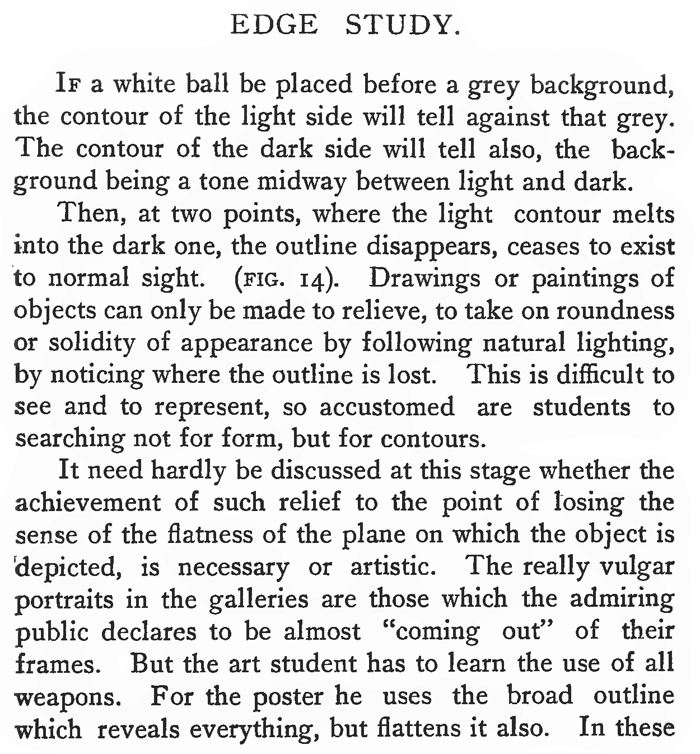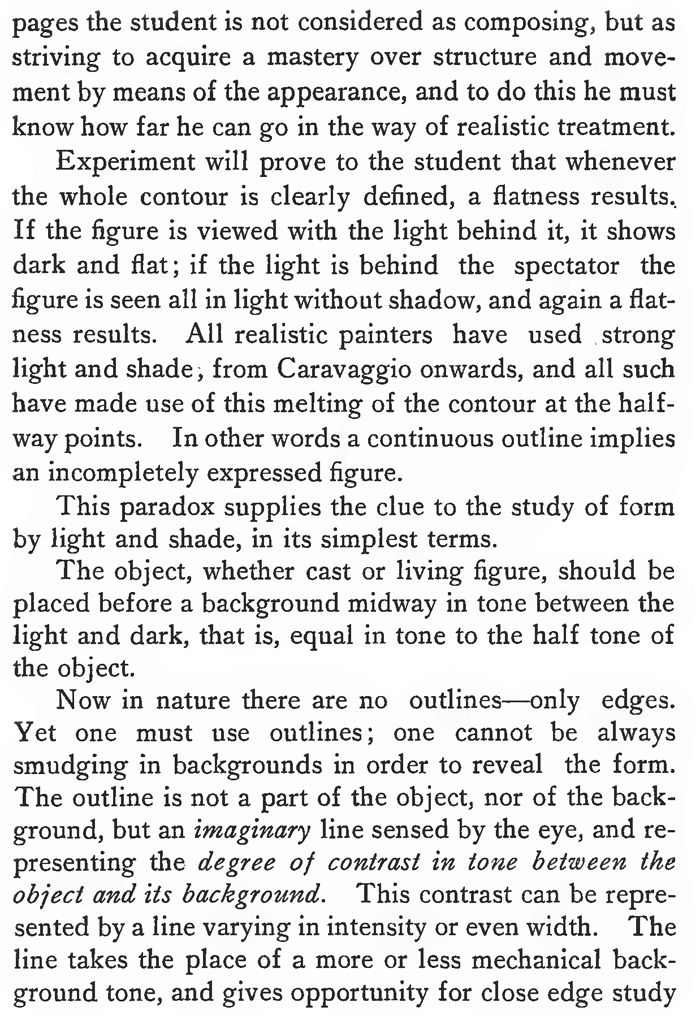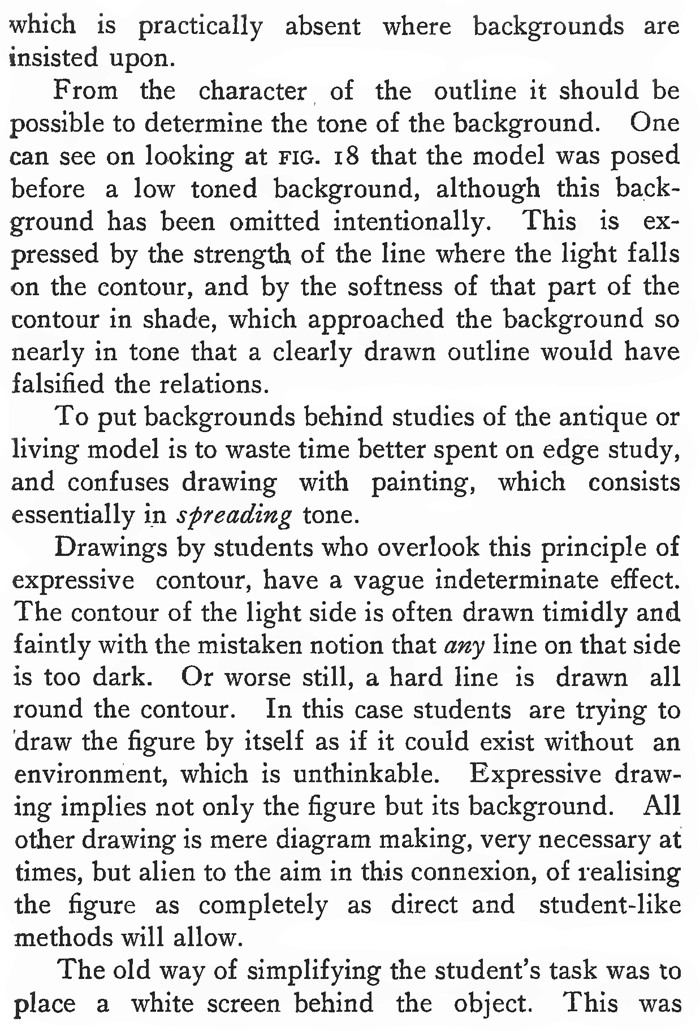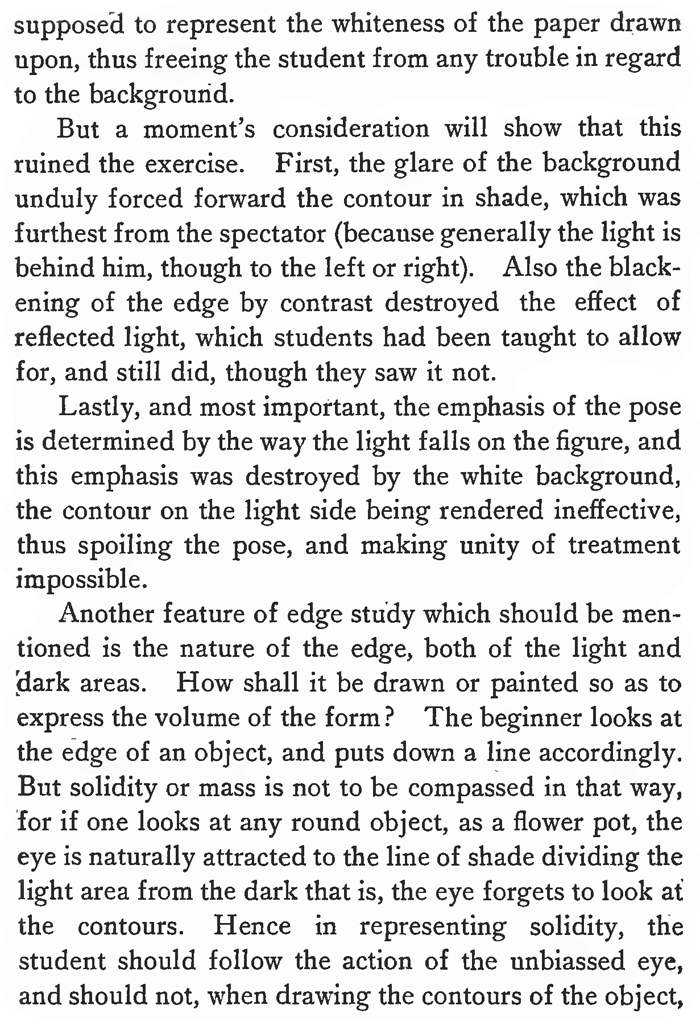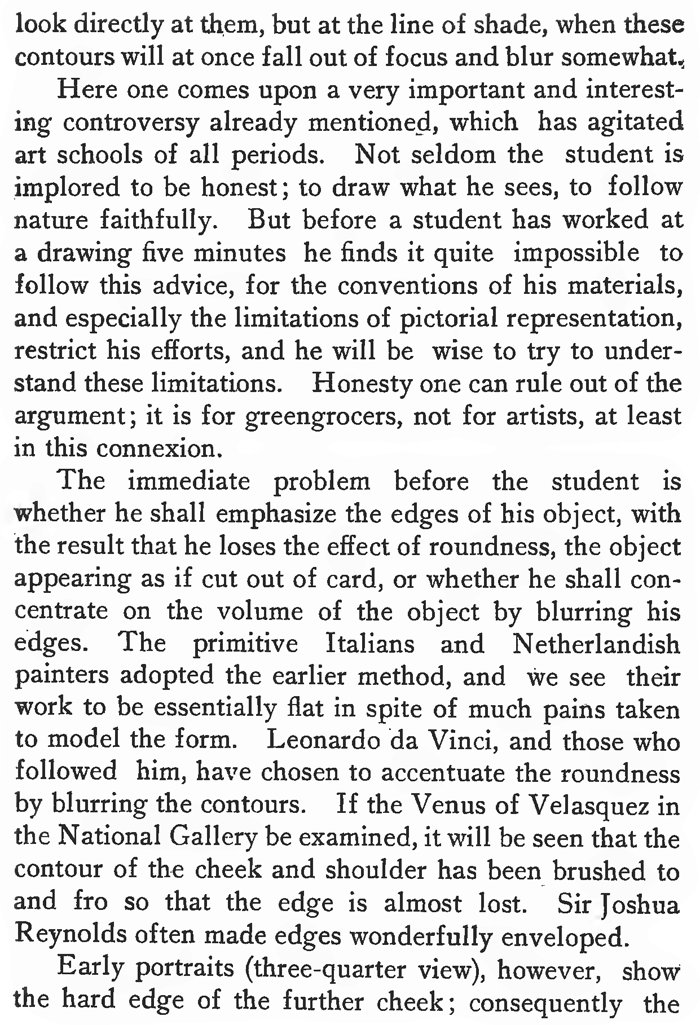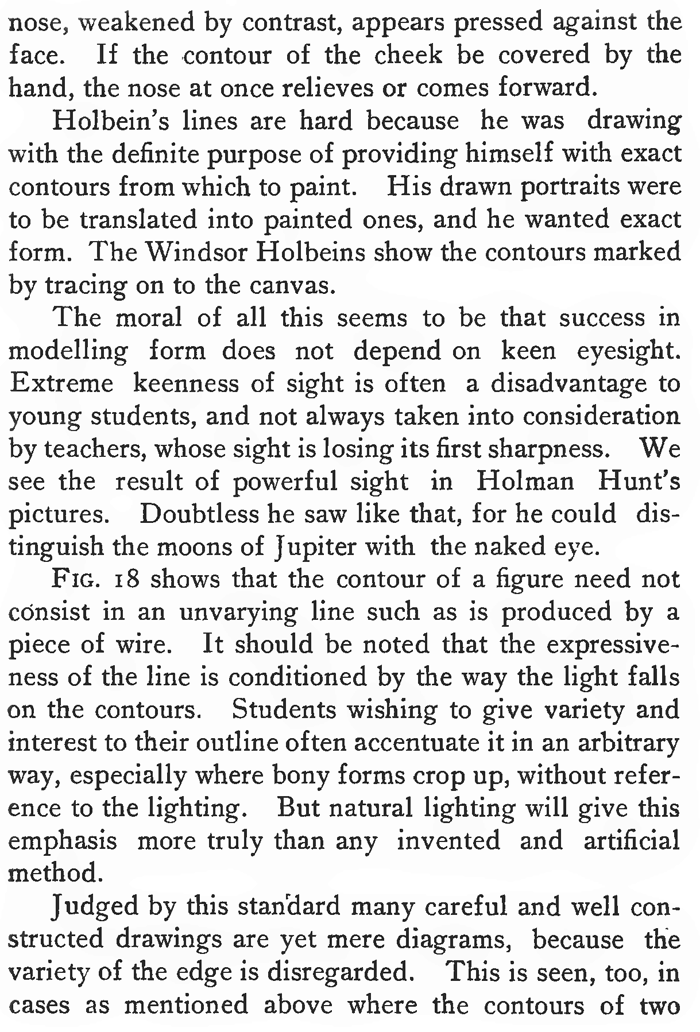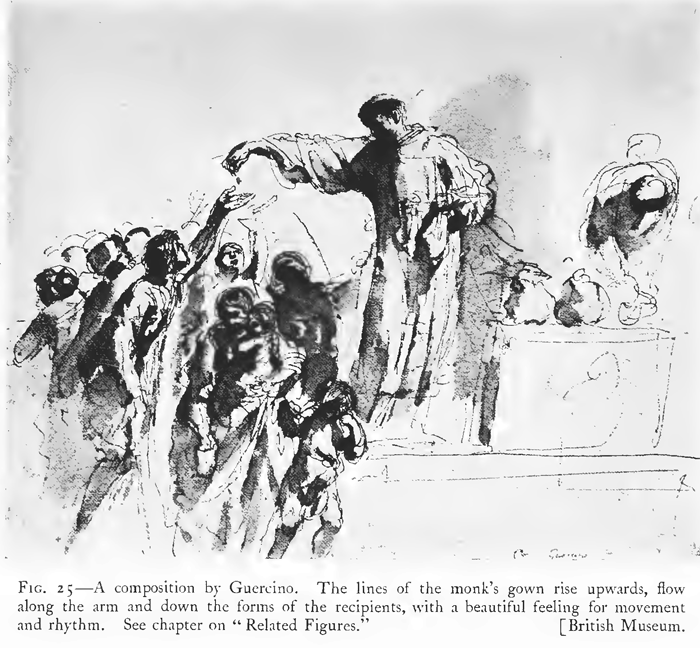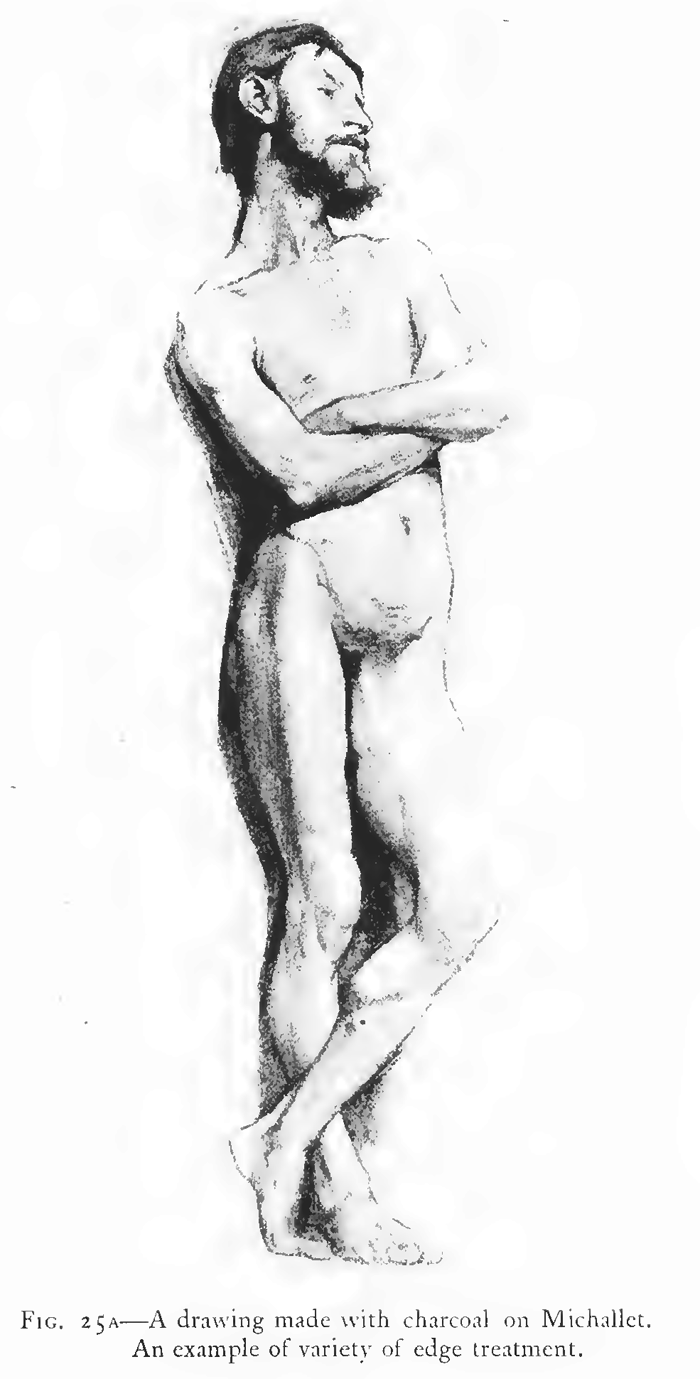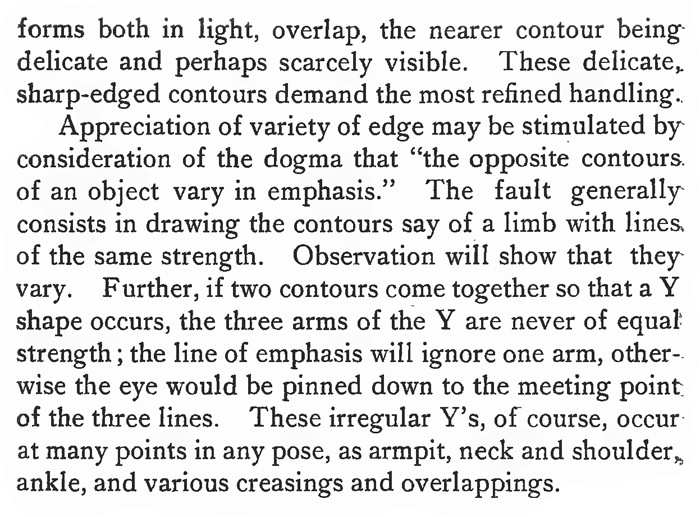Home > Directory of Drawing Lessons > How to Improve Your Drawings > Draw Lights & Shadows > Drawing Edges with Lights and Shadows
How to Draw Edges by Drawing Lights and Shadows Instead of Drawing Flat Outlines to Create Illusion of Form
|
|
The Text Above is Actually Images, the text is below if you need to copy some of it. EDGE STUDY : Drawing the Outline of Subjects such as Objects and Figures, with Light and Shade.If a white ball be placed before a gray background, the contour of the light side will tell against that gray The contour of the dark side will tell also, the background being a tone midway between light and dark. Then, at two points, where the light contour melts into the dark one, the outline disappears, ceases to exist to normal sight. (FIG. 14). Drawings or paintings of objects can only be made to relieve, to take on roundness or solidity of appearance by following natural lighting, by noticing where the outline is lost. This is difficult to see and to represent, so accustomed are students to searching not for form, but for contours. It need hardly be discussed at this stage whether the achievement of such relief to the point of losing the sense of the flatness of the plane on which the object is `depicted, is necessary or artistic. The really vulgar portraits in the galleries are those which the admiring public declares to be almost "coming out" of their frames. But the art student has to learn the use of all weapons. For the poster he uses the broad outline which reveals everything, but flattens it also. In these pages the student is not considered as composing, but as striving to acquire a mastery over structure and movement by means of the appearance, and to do this he must know how far he can go in the way of realistic treatment. Experiment will prove to the student that whenever the whole contour is clearly defined, a flatness results. If the figure is viewed with the light behind it, it shows dark and flat; if the light is behind the spectator the figure is seen all in light without shadow, and again a flatness results. All realistic painters have used strong light and shade; from Caravaggio onwards, and all such have made use of this melting of the contour at the halfway points. In other words a continuous outline implies an incompletely expressed figure. This paradox supplies the clue to the study of form by light and shade, in its simplest terms. The object, whether cast or living figure, should be placed before a background midway in tone between the light and dark, that is, equal in tone to the half tone of the object. Now in nature there are no outlines—only edges. Yet one must use outlines ; one cannot be always smudging in backgrounds in order to reveal the form. The outline is not a part of the object, nor of the background, but an imaginary line sensed by the eye, and representing the degree of contrast in tone between the object and its background. This contrast can be represented by a line varying in intensity or even width. The line takes the place of a more or less mechanical background tone, and gives opportunity for close edge study which is practically absent where backgrounds are insisted upon. From the character of the outline it should be possible to determine the tone of the background. One can see on looking at FIG. 18 that the model was posed before a low toned background, although this background has been omitted intentionally. This is expressed by the strength of the line where the light falls on the contour, and by the softness of that part of the contour in shade, which approached the background so nearly in tone that a clearly drawn outline would have falsified the relations. To put backgrounds behind studies of the antique or living model is to waste time better spent on edge study, and confuses drawing with painting, which consists essentially in spreading tone. The old way of simplifying the student's task was to place a white screen behind the object. This was supposed to represent the whiteness of the paper drawn upon, thus freeing the student from any trouble in regard to the background. But a moment's consideration will show that this ruined the exercise. First, the glare of the background unduly forced forward the contour in shade, which was furthest from the spectator (because generally the light is behind him, though to the left or right). Also the blackening of the edge by contrast destroyed the effect of reflected light, which students had been taught to allow for, and still did, though they saw it not. Lastly, and most important, the emphasis of the pose is determined by the way the light falls on the figure, and this emphasis was destroyed by the white background, the contour on the light side being rendered ineffective, thus spoiling the pose, and making unity of treatment impossible. Another feature of edge study which should be mentioned is the nature of the edge, both of the light and dark areas. How shall it be drawn or painted so as to express the volume of the form? The beginner looks at the edge of an object, and puts down a line accordingly. But solidity or mass is not to be compassed in that way, for if one looks at any round object, as a flower pot, the eye is naturally attracted to the line of shade dividing the light area from the dark that is, the eye forgets to look at the contours. Hence in representing solidity, the student should follow the action of the unbiased eye, and should not, when drawing the contours of the object, look directly at them, but at the line of shade, when these contours will at once fall out of focus and blur somewhat, Here one comes upon a very important and interesting controversy already mentioned, which has agitated art schools of all periods. Not seldom the student is implored to be honest; to draw what he sees, to follow nature faithfully. But before a student has worked at a drawing five minutes he finds it quite impossible to follow this advice, for the conventions of his materials, and especially the limitations of pictorial representation, restrict his efforts, and he will be wise to try to understand these limitations. Honesty one can rule out of the argument; it is for greengrocers, not for artists, at least in this connection The immediate problem before the student is whether he shall emphasize the edges of his object, with the result that he loses the effect of roundness, the object appearing as if cut out of card, or whether he shall concentrate on the volume of the object by blurring his edges. The primitive Italians and Netherlandish painters adopted the earlier method, and we see their work to be essentially flat in spite of much pains taken to model the form. Leonardo da Vinci, and those who followed him, have chosen to accentuate the roundness by blurring the contours. If the Venus of Velasquez in the National Gallery be examined, it will be seen that the contour of the cheek and shoulder has been brushed to and fro so that the edge is almost lost. Sir Joshua Reynolds often made edges wonderfully enveloped. Early portraits (three-quarter view), however, show the hard edge of the further cheek ; consequently the nose, weakened by contrast, appears pressed against the face. If the contour of the cheek be covered by the hand, the nose at once relieves or comes forward. Holbein's lines are hard because he was drawing with the definite purpose of providing himself with exact contours from which to paint. His drawn portraits were to be translated into painted ones, and he wanted exact form. The Windsor Holbeins show the contours marked by tracing on to the canvas. The moral of all this seems to be that success in modeling form does not depend on keen eyesight. Extreme keenness of sight is often a disadvantage to young students, and not always taken into consideration by teachers, whose sight is losing its first sharpness. We see the result of powerful sight in Holman Hunt's pictures. Doubtless he saw like that, for he could distinguish the moons of Jupiter with the naked eye. FIG. 18 shows that the contour of a figure need not consist in an unvarying line such as is produced by a piece of wire. It should be noted that the expressiveness of the line is conditioned by the way the light falls on the contours. Students wishing to give variety and interest to their outline often accentuate it in an arbitrary way, especially where bony forms crop up, without reference to the lighting. But natural lighting will give this emphasis more truly than any invented and artificial method. Judged by this standard many careful and well constructed drawings are yet mere diagrams, because the variety of the edge is disregarded. This is seen, too, in cases as mentioned above where the contours of two forms both in light, overlap, the nearer contour being delicate and perhaps scarcely visible. These delicate, sharp-edged contours demand the most refined handling..
Fin. 25A—A drawing made with charcoal on Michallet. An example of variety of edge treatment. |
Privacy Policy ...... Contact Us





